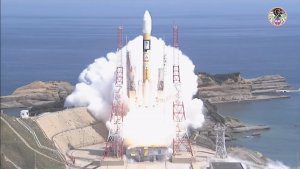In what is regarded as a coup for Mitsibushi Heavy Industries (MHI), it was announced that Inmarsat has eschewed the main commercial launch providers (Arianespace, SpaceX, ILS etc) and instead selected the Japanese H-IIA (H2A) rocket to launch the first of its new Inmarsat 6 communications spacecraft. The 6,000 kg mobile communications satellite, INMARSAT-6 F1, is currently under construction by Airbus Defence and Space. It is scheduled for launch to its operational geostationary orbit in 2020 from the Tanegashima launch site in Japan. The H-IIA rocket is financed by the Japanese space agency JAXA, but is built, operated, and marketed commercially by MHI.

A H-2A204 rocket lifts off from Tanegashima Space Center carrying MICHIBIKI 3. Courtesy MHI
Inmarsat’s sixth generation (I-6) fleet carries both L-band and Ka-band capacity. The L-band payload is designed to offer very low-cost mobile services including Internet of Things (IoT) applications. The Ka-band payload adds capacity to the Global Xpress broadband services offering from the firm.
While the H-IIA is regarded as an expensive rocket, it is reliable. MHI hopes that the relationship could yield to more launch orders, especially for its new H-3 launch vehicle.








